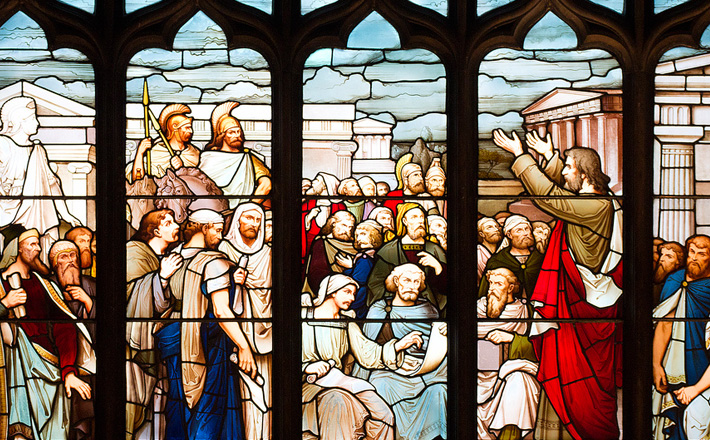Commentary on 1 Peter 3:13-22
The letter of 1 Peter opens by identifying Christian readers as a membership of sojourners, chosen people, and dispersed communities (1:1-2).
It is an eclectic association of communities, located in different places with different geographical and cultural histories across Asia Minor (1:1; Pontus, Galatia, Cappadocia, Asia, and Bithynia) and the Roman world (2:13-14; 5:9, 13). From the very beginning, 1 Peter asserts this is a new kinship group—a new demographic and dynamic—anchored in the event of resurrection (1:3; 3:21).
From the perspective of 1 Peter, faith in the resurrection connects believers—near and far—to each other in new ways. It forms a new existence the letter seeks to name and describe. Within the letter, the novelty of Christian identity is characterized by how expansive and inclusive it is and thus, unfamiliar and possibly uncomfortable for those inside and outside its communities. One of the tasks of the letter is to make readers more conversant in Christian communal life and identity (1:15-17; 2:9; 3:8-12). Indeed, to understand resurrection, according to 1 Peter, is to involve oneself in the work of redefinition, expansion, and community building.
Today’s lectionary passage highlights the dangers of living in a community created and transformed by a proclamation of resurrection. Because of the visible differences they exhibit in their interactions with each other and the world (3:13-16), the letter asserts believers in Jesus Christ should expect resistance from those outside the community. Yet, these differences in behavior are not simply about interaction and exchange. The unique identity of “Christian” (4:14-16) includes interacting in mutuality with each other as brothers, sisters, and siblings across societal boundaries, such as:
(1) social status (2:18-3:7; for example, servants, married couples, singles);
(2) age and experience (5:1-5; for example, elders and youth); and even
(3) ethnicity and/or regional ancestries and cultural identifications, as stated above (see also, 5:9, 12-13).
Three points are worth noting about the resistance and risks to authentic Christian practice, fellowship, and identity addressed by today’s passage.
- Defend yourself! 1 Peter 3:15 encourages readers to prepare a defense (apologia) or counter argument for any public accusations of social misconduct, rebellion, or disruption levied against them by outsiders or non-Christians. The language of defense (apologia) represents a posture or response believers give to outsiders challenging their novel social configurations and questioning their legitimacy within the larger Roman world. Defending oneself against public opponents is not a new story in the New Testament. For example, in Acts 22:1-21, Paul prepares to defend himself against his Jewish brothers accusing him of being an apostate and agitator (see also Acts 25:16). Paul responds by defending himself in a public ad hoc courtroom, of sorts. In contrast, it does not appear 1 Peter anticipated physical violence, as much as the letter anticipated social interrogation and disgrace, ostracism, and typecasting (4:12-16).
- Descent and ascent. In 1 Peter 3:18-22, the letter seems to fill in the story of the three-day period between the time of Jesus’ death and resurrection on the frontend and the time between his resurrection and ascension on the backend. There are a few items worth observing. First, the letter does not use any explicit Greek term for “hell” common in the NT, such as: Gehenna (geenna, for example, Matthew 5:22, 29), Hades (hades, for example, Matthew 16:18), or even Tartarus (tartaroo, 2 Peter 2:4). Rather, it alludes to hell or some form of a netherworld by referring, rather ambiguously, to “spirits in prison” (3:19) and “the dead” (4:6). Scholars debate whether 3:19-20 refers to Christ’s witness to those alive and disobedient at the time of the flood or, whether it is a link to 4:6, in which Christ is either proclaiming salvation to all the dead ones or proclaiming the coming judgment only to those Christians who died before his death and resurrection. This is a highly contested passage by scholars. What is clear in this passage, however, is that Jesus, as the resurrected Christ, traverses space and time in a form incomprehensible to human logic. 1 Peter represents the exceptional and extraordinary nature of Jesus’ movements by duplicating the same Greek form of the verb for “having gone” (poreuomai) in Jesus’ descent in 3:19 and his ascent in 3:22. It appears the letter is attempting to express the continuity of Jesus’ movements after his crucifixion-death, both before and after the resurrection moment. Nonetheless, it is worth mentioning that 1 Peter 3:19 literally states, “[Christ] having gone (poreutheis), he made proclamation to the spirits in prison.” Likewise, 1 Peter 3:22 literally states, “through the resurrection of Jesus Christ, who is at the right hand of God, having gone (poreutheis) into heaven.”
- Noah tradition revisited. The last item worth noting is the use of the Noah tradition, which does not occur often in the NT literature. The reference to Noah in verse 20 is closely related to the role of baptism elucidated in verses 21-22. In the gospel traditions, such as Luke 17:26-27 or Matthew 24:37, the Noah tradition is interpreted in relationship to the parousia and the unspecified coming of the kingdom of God. In 1 Peter, the Noah tradition is deployed in a way that is less focused on eschatology, and more focused on soteriology. The Noah tradition is linked to 1 Peter’s perspective about salvation and baptism. In turn, baptism is an item in the catalogue of Christian practice evident in the letter (preaching, 1:12; prayer, 3:7, 4:7; hospitality, 4:9).
Today’s lectionary passage offers a lot for preachers to consider. What stands above the rest, however, is the opportunity to ask ourselves the question: What are the activities of new life this resurrection season demands of our communities, locally and globally? And hopefully we do not stop there; but we embrace the invitation to ponder other questions, such as: What are the new practices, even in the throes of social distancing, that we can do to build connection, relationship, and belonging that supports and extends life? What are the opportunities to accompany each other in ways that are visibly instructive to a world that prefers separation and “everyone for themselves”? In what ways does this passage offer us an opportunity to take seriously the power of collective journeying, mutuality, and faith in Jesus, who has already suffered, died, and lived again? May we find a shared path forward in resurrection life so that even if we descend temporarily into despair, sorrow, and death, like Christ, we also ascend into new life that is impactful, lasting, glorious, and generative for all. In this way, we can announce renewal, revitalization, and hope in this season.


May 17, 2020